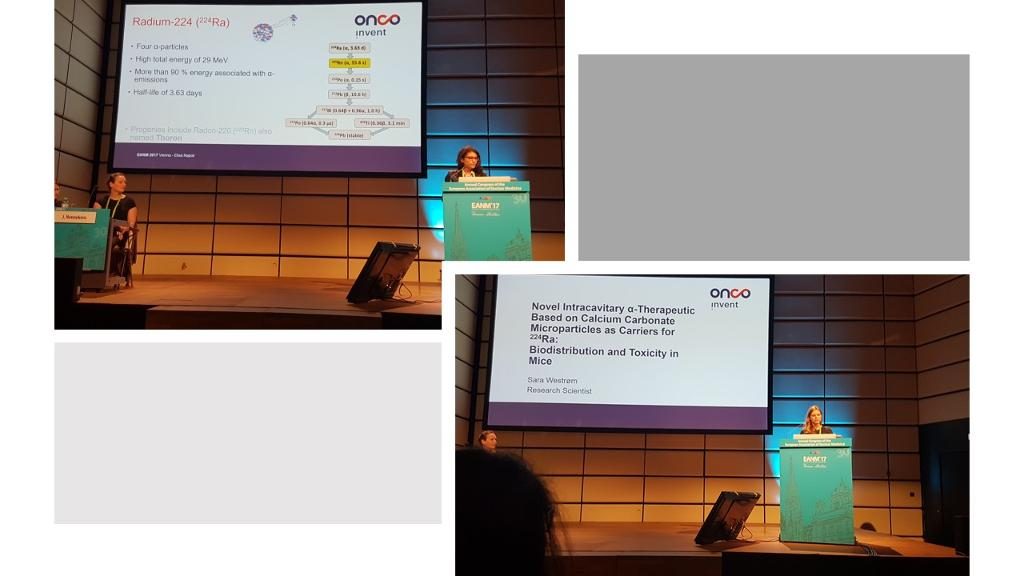Oncoinvent presents Radspherin® preclinical data at 30th Annual Congress of the European Association of Nuclear Medicine (EANM)

Press Release 06.2017 Work presented indicates that, with certain precautions, 224Ra based biomedical products can be used in a safe manner for the hospital staff and patients. In vivo studies show that 224Ra-labeled CaCO3 microparticles could be safely administered in mice at therapeutically relevant doses and with a high degree of intraperitoneal retention. The novel α-emitting microparticles have properties that make them a promising new modality for intracavitary cancer therapy.
Oncoinvent, a preclinical stage company committed to developing new innovative products to provide better treatment options to cancer patients, announced new data from the ongoing preclinical development of Radspherin®.
These data were provided in oral presentations given by research scientists Elisa Napoli and Sara Westrøm during the Sunday morning session of the scientific program at the European Association of Nuclear Medicine (EANM) in Vienna, Austria.
Abstracts of the presentations are listed below.
Re-localization of 212Pb from 224Ra sources due to thoron (220Rn) diffusion
E. Napoli1,2,3, S. Westrøm1,2,3, T. B. Bønsdorff3, Ø. S. Bruland1,2,3, R. H. Larsen4;
1 University of Oslo, Oslo, NORWAY, 2 The Norwegian Radium Hospital, Oslo, NORWAY, 3 Oncoinvent AS, Oslo, NORWAY, 4 Sciencons AS, Oslo, NORWAY.
Aim: Alpha-particle-emitting radium nuclides have been the subject of considerable biomedical research due to their highly localized effect. Radium-224, with a convenient half-life of 3.6 days, has promising properties for use against micro-metastatic disease. The aim of this work was to investigate the radiation safety aspects with a focus on thoron (220Rn) diffusion from its parent nuclide 224Ra. Thoron diffusion was studied for 224Ra either as free cation in solution or bound to biocompatible calcium carbonate (CaCO3) microparticles. Materials and Methods: Radium-224 was extracted from 228Th immobilized on Actinide Resin in 1 M hydrochloric acid (HCl). The acid was evaporated and the residue reconstituted in 0.1 M HCl and subsequently neutralized with ammonium acetate. The CaCO3 microparticles were prepared by precipitation of the combination of sodium carbonate and calcium chloride solutions. Thereafter, the microparticles were radiolabeled by mixing with 224Ra solution at neutral pH. Re-localization of 212Pb, due to thoron escape from solutions of free 224Ra and 224Ra-CaCO3 microparticle suspensions, was studied in various experimental setups. The potential leakage of thoron was examined from frequently used containers such as: 1.5/5 ml Eppendorf tubes, 6 ml Chromacol head-space injection vials capped and crimped with a stopper and different size of syringes. In addition, the influence of liquid volume on thoron diffusion into air was studied from open vials. Due to its short physical half-life of 56 s, thoron diffusion into the air was evaluated by measuring its decay product 212Pb, which has a longer half-life of 10.64 h. Gamma-counting was performed with the Hidex Automatic Gamma Counter (Turku, Finland). Results: The results indicate that free cationic 224Ra solutions and 224Ra-CaCO3 microparticle suspensions can be used in a safe manner, without significant leakage of thoron, when contained in vials or syringes. The data shows that at very low volumes i.e. 10-100 μl, there is significant diffusion of thoron from free cationic 224Ra solutions into air from open vials. Less diffusion from open vials was observed with 224Ra-CaCO3 suspensions. Diffusion from 10 μl volumes was between 70% and 95% less for 224Ra-CaCO3 in comparison with free cationic 224Ra solutions. Conclusion: When considering the low expected activity level needed for a therapeutic dosing, the current work indicates that, with certain precautions, 224Ra based biomedical products can be used in a safe manner for the hospital staff and patients.
Novel Intracavitary α-Therapeutic Based on Calcium Carbonate Microparticles As Carriers for 224Ra: Biodistribution and Toxicity in Mice
S. Westrøm1,2,3, T. B. Bønsdorff3, M. M. Malenge3, Ø. S. Bruland1,2,3, R. H. Larsen4,
1 University of Oslo, Oslo, NORWAY, 2 The Norwegian Radium Hospital, Oslo University Hospital, Oslo, NORWAY, 3 Oncoinvent AS, Oslo, NORWAY, 4 Sciencons AS, Oslo, NORWAY.
Aim: Peritoneal carcinomatosis occurs when cancer cells from a primary tumor in an adjacent organ migrate into the peritoneal cavity and cause micrometastases. Intraperitoneal radiation therapy with β-emitting 32P-colloid was previously used in treatment of ovarian cancer. It was shown to be as effective as adjuvant cisplatin, but resulted in higher incidence of late bowel complications, most likely caused by the several millimeters range of 32P-electrons. Our aim was to design an intracavitary treatment for peritoneal carcinomatosis with highly localized effect to minimize risk of irradiation of surrounding normal tissues. We have developed a novel therapeutic based on CaCO3 microparticles as carriers for the α-emitter 224Ra, a nuclide which emits four α-particles during its decay and has considerably shorter range than 32P. Here, the preparation of the product is presented along with evaluation of tissue distribution and toxicity in mice. Materials and Methods: CaCO3 microparticles with median diameters from 2-20 μm were prepared by spontaneous precipitation and radiolabeled by co-precipitation of 224Ra on the particle surface. The labeling yield was determined and retention of 224Ra on the microparticles was investigated in vitro. Biodistribution after intraperitoneal administration of the radiolabeled microparticles was studied in immunodeficient athymic nude mice and compared with that of free 224Ra. Toxicity of the 224Ra-labeled CaCO3 microparticles was evaluated in immunocompetent BALB/c mice. Results: Radiolabeling of the CaCO3 microparticles was successful and resulted in high yield. Experiments also showed that 224Ra was well retained on the microparticles for several days in vitro. Because of the bone-seeking capacity of 224Ra, the stability of the radiolabeled particles in vivo could be determined from the uptake of 224Ra in mice femurs. A fundamental shift in tissue radiation exposure was observed when free 224Ra was compared with 224Ra-labeled CaCO3 microparticles. The femur uptake of 224Ra was significantly reduced and radioactivity on intraperitoneal tissues and surfaces was substantially increased after administration of 224Ra-labeled CaCO3 microparticles. In immunocompetent mice, doses up to 1000 kBq/kg of 224Ra-labeled microparticles were well-tolerated and no clinical signs of toxicity were observed. Conclusion: Efficient 224Ra-labeling of the CaCO3 microparticles was achieved with high retention of the radionuclide by the particles in vitro. The in vivo studies show that 224Ra-labeled CaCO3 microparticles could be safely administered in mice at therapeutically relevant doses and with a high degree of intraperitoneal retention. In conclusion, the novel α-emitting microparticles have properties that make them a promising new modality for intracavitary cancer therapy.
About Radspherin®
Radspherin® is a novel alpha-emitting radioactive microsphere designed for treatment of metastatic cancers in body cavities. The radium based therapeutic, Radspherin® has shown strong and consistent anticancer activity without any signs of product related toxicity in preclinical studies. It is anticipated that the product can potentially treat several forms of metastatic cancer. The first clinical indication for Radspherin® will be treatment of peritoneal carcinomatosis. Peritoneal carcinomatosis is one of the most serious complications of gastrointestinal and gynecological malignancies.
About Oncoinvent
Oncoinvent AS is a privately held Norwegian company based in Oslo, Norway. The company is committed to developing new innovative products to provide better treatment options to cancer patients.
The company’s founders started Oncoinvent in 2010 with a view to designing better cancer treatments by applying known physical and chemical principles of selected materials in new ways to maximize their medical benefit while minimizing potential safety concerns. This approach has allowed the company to develop a rich development pipeline and to explore multiple technological avenues before selecting a lead product candidate for preclinical testing.
The company is currently in late stage preclinical testing with its lead product candidate Radspherin®.
For further information, please contact:
Jan A. Alfheim, Chief Executive Officer
Cell: +47 46 44 00 45
Email: alfheim@oncoinvent.com
IR enquiries:
Ole Peter Nordby, Chief Financial Officer
Cell: +47 41 28 71 79
Email: nordby@oncoinvent.com



